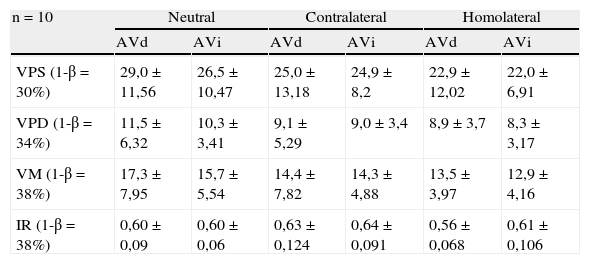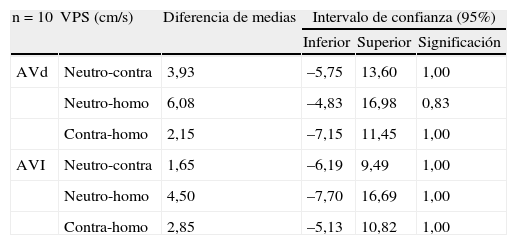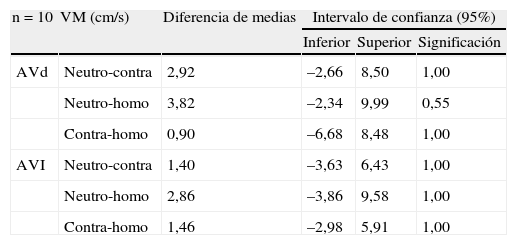Los test premanipulativos para la insuficiencia vertebrobasilar (TPIBV) suelen incorporar la rotación cervical para comprobar la solvencia de las arterias vertebrales (AV), aunque las investigaciones acerca del efecto de la rotación en el flujo de la AV discrepan y arrojan dudas en cuanto a la validez de las pruebas. Como un primer paso en esta línea el objetivo fue comprobar el efecto de la rotación cervical en los parámetros hemodinámicos de la AV en sujetos sanos.
Material y métodoSe contó con 10 mujeres voluntarias sanas de 18 a 23 años (media: 20,3; DT: 1,64 años) a las que se le realizaron ecografías Doppler bilaterales en el segmento de la AV suboccipital (AV3) en la posición de rotación neutra, contralateral y homolateral. Se calcularon la velocidad del pico sistólico (VPS), velocidad del pico diastólico (VPD), velocidad media (VM) e índice de resistencia (IR). Los datos se analizaron con una ANOVA de medidas repetidas y las comparaciones se realizaron con la corrección de Bonferroni (SPSS v15.0; IC del 95%).
ResultadosNo se detectaron diferencias estadísticamente significativas en cuanto a la lateralidad y la rotación cervical ni en VPS (FVPS=0,935; p=0,47) ni en VPD (FVPD=1,067; p=0,39), ni en VM (FVM=1,172; p=0,34), ni en IR (FIR=1,183; p=0,33). Debe destacarse la baja potencia de los análisis (entre el 30 y el 38%) por lo que la ausencia de diferencias debe considerarse con precaución.
ConclusionesLos parámetros hemodinámicos de la AV no se modificaron en sujetos sanos con las rotaciones cervicales, cuestión que debe ser investigada en sujetos con insuficiencia vertebrobasilar.
The pre-manipulative vertebrobasilar insufficiency tests (PVBIT) generally incorporate cervical rotation to verify the solvency of the vertebral arteries (VA). However, research on the effect of rotation on VA blood flow differ and question the validity of the tests. The first aim of this study was to verify the effect of cervical rotation on the hemodynamic parameters of the VAs in healthy subjects.
Material and methodTen healthy female volunteers, aged 18 to 23 years (mean: 20.3, SD: 1.64 years), were subjected to bilateral Doppler ultrasonographies over the suboccipital segment of the AV (AV3) with neutral, contralateral and ipsilateral cervical rotation positions. We calculated peak systolic velocity (PSV), peak diastolic velocity (PDV), mean velocity (MV) and resistance index (RI). The data were analyzed with repeated measures ANOVA and comparisons were made with Bonferroni correction (SPSS v15.0, C.I. 95%).
ResultsNo statistically significant differences were detected regarding lateralization or rotation in the values of PSV (FPSV=0.935, P=.47), or PDV (FPDV=1.067, P=.39), or MV (FMV=1.172, P=.34), or RI (FRI=1.183, P=.33). The low power of analysis (between 30 and 38%) should be noted and thus the absence of differences should be observed with caution.
ConclusionsHemodynamic parameters of the VA did not change with cervical rotations in healthy women so that this question should be studied in patients with vertebrobasilar insufficiency.
Artículo
Si ya tiene sus datos de acceso, clique aquí.
Si olvidó su clave de acceso puede recuperarla clicando aquí y seleccionando la opción "He olvidado mi contraseña".Comprando el artículo el PDF del mismo podrá ser descargado
Precio 19,34 €
Comprar ahora












